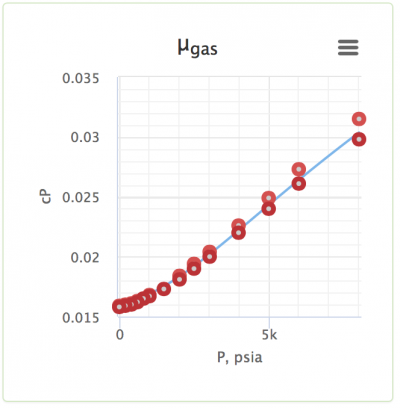Difference between revisions of "Lee correlation"
From wiki.pengtools.com
(→Brief) |
(→References) |
||
| (6 intermediate revisions by the same user not shown) | |||
| Line 1: | Line 1: | ||
__TOC__ | __TOC__ | ||
| − | == | + | == Lee gas viscosity correlation == |
[[Lee correlation]] is the empirical correlation for the gas viscosity published in '''1966'''. | [[Lee correlation]] is the empirical correlation for the gas viscosity published in '''1966'''. | ||
| − | [[File:LeeSample.png|thumb|right| | + | [[File:LeeSample.png|thumb|right|400px|link=https://www.pengtools.com/pvtCalculator|Lee gas viscosity correlation at T=340F in the PVT software at pengtools.com|right]] |
| − | + | == Math & Physics == | |
:<math> \mu_g = \frac{K\ e^{(X\ \rho_g^Y)}}{10000} </math><ref name= Lee/> | :<math> \mu_g = \frac{K\ e^{(X\ \rho_g^Y)}}{10000} </math><ref name= Lee/> | ||
| Line 22: | Line 22: | ||
:<math> \rho_g = \frac{1}{62.428} \times \frac{28.967\ SG_g\ p}{z\ 10.732\ T}</math> | :<math> \rho_g = \frac{1}{62.428} \times \frac{28.967\ SG_g\ p}{z\ 10.732\ T}</math> | ||
| − | + | == Application range == | |
| − | |||
| − | |||
| − | |||
:<math> 560 \le T < 800 </math> | :<math> 560 \le T < 800 </math> | ||
| Line 31: | Line 28: | ||
:<math> 100 < P \le 8000</math> | :<math> 100 < P \le 8000</math> | ||
| − | + | == Nomenclature == | |
:<math> \rho_g </math> = gas density, g/cm3 | :<math> \rho_g </math> = gas density, g/cm3 | ||
:<math> \mu_g </math> = gas viscosity, cp | :<math> \mu_g </math> = gas viscosity, cp | ||
| Line 40: | Line 37: | ||
:<math> z </math> = gas compressibility factor, dimensionless | :<math> z </math> = gas compressibility factor, dimensionless | ||
| − | + | == References == | |
<references> | <references> | ||
<ref name=Lee>{{cite journal | <ref name=Lee>{{cite journal | ||
| Line 56: | Line 53: | ||
[[Category:pengtools]] | [[Category:pengtools]] | ||
[[Category:PVT]] | [[Category:PVT]] | ||
| + | |||
| + | {{#seo: | ||
| + | |title=Lee gas viscosity correlation | ||
| + | |titlemode= replace | ||
| + | |keywords=gas viscosity, Lee correlation | ||
| + | |description=Lee correlation is the empirical correlation for the gas viscosity published in 1966. | ||
| + | }} | ||
Latest revision as of 11:56, 5 October 2020
Contents
Lee gas viscosity correlation
Lee correlation is the empirical correlation for the gas viscosity published in 1966.
Math & Physics
where
Application range
Nomenclature
 = gas density, g/cm3
= gas density, g/cm3 = gas viscosity, cp
= gas viscosity, cp = gas molecular weight, dimensionless
= gas molecular weight, dimensionless = pressure, psia
= pressure, psia = gas specific gravity, dimensionless
= gas specific gravity, dimensionless = temperature, °R
= temperature, °R = gas compressibility factor, dimensionless
= gas compressibility factor, dimensionless
References
- ↑ Lee, A. B.; Gonzalez, M. H.; Eakin, B. E. (1966). "The Viscosity of Natural Gases". Journal of Petroleum Technology (SPE-1340-PA).









